Citizen’s Guide to Protecting the Mississippi Gulf Coast from Marine Debris
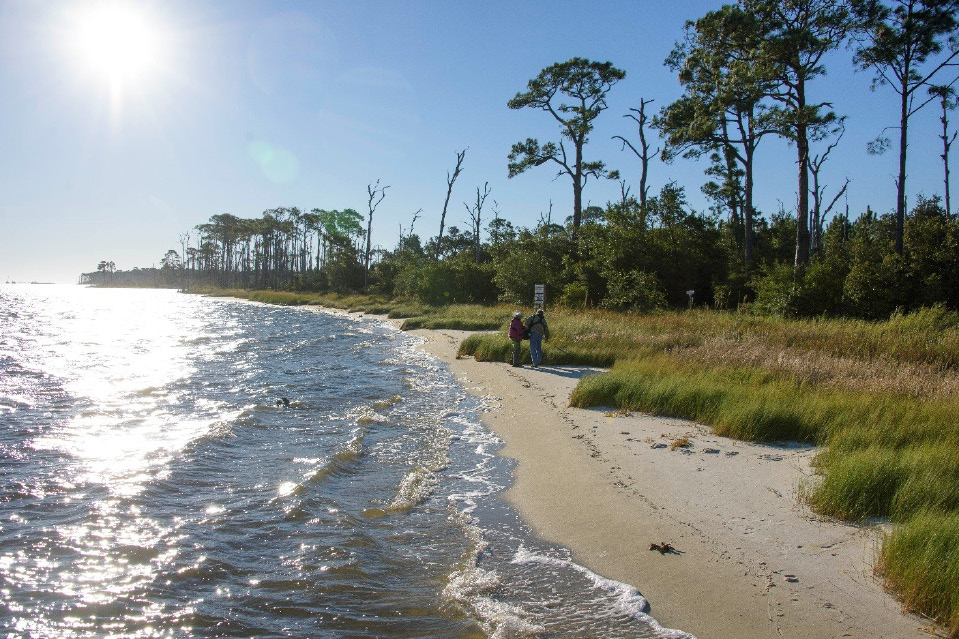
Figure 1. Volunteers clean up the Mississippi Coast. Photo by Kevin Hudson, Agricultural Communications.
Oceans and estuaries are two important ecosystems for plants, wildlife, and humans. Oceans are vast areas of salt water, such as the Atlantic or Pacific Oceans, which also encompass smaller regions within them, such as the Gulf of Mexico. Estuaries occur where rivers meet the sea, and fresh and salt water mix, in areas such as the Mississippi Sound and Bay St. Louis. Together, oceans and estuaries provide many services that are helpful to humans; these are often referred to as ecosystem services, or nature’s benefits. These ecosystems support the production of seafood and provide recreational opportunities such as boating, swimming, fishing, and bird-watching.
Human activities pose many threats to oceans and estuaries. Such threats include overfishing; ocean acidification caused by uptake of carbon dioxide from the atmosphere; bulkheads; buildings; boat propellers that can damage and destroy habitat; and nutrient pollution resulting in algal blooms that reduce oxygen in water and kill various species. In addition to the aforementioned threats, a global issue that warrants immediate citizen attention and concern is marine debris, or litter pollution.
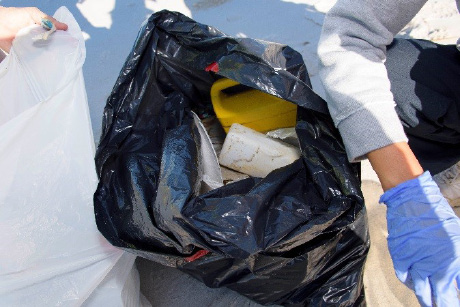
What Is Marine Debris?
Marine debris is “any persistent solid material that is manufactured or processed and directly or indirectly, intentionally or unintentionally disposed of or abandoned in the marine environment or the Great Lakes” (NOAA 2017). Marine debris includes various discarded items, including abandoned fishing gear, such as ghost nets, fishing line, old buoys, crab traps, and abandoned/wrecked boats. Marine debris also includes basic human trash items, like food wrappers, paper, glass, metal, hygiene products, containers, rubber, and wood.
Several million tons of plastic have been produced since the middle of the last century—people use more than 200 million tons annually—and it is now the primary type of marine debris. In fact, plastics account for 60–80 percent of marine litter; that number reaches 90–95 percent in some areas (Moore 2008). Much of the plastic debris is single-use items, such as plastic bottles or plastic cutlery. If plastic pollution is not removed from the environment, it can be weathered or broken into smaller pieces of plastic, called microplastics. Microplastics can also be manufactured (e.g., small plastic pellets in face wash and toothpaste). No matter the source, microplastics are defined as any plastic that is smaller than 5 millimeters.
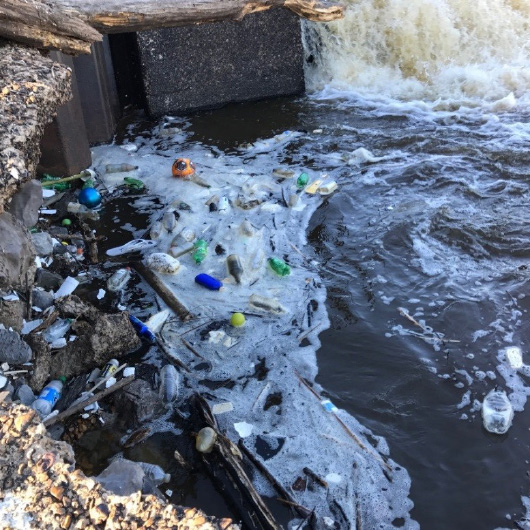
Where Does Marine Debris Come From?
Marine debris can come from land sources during flooding and natural disasters. During these events, rain or wind can move litter on land into ditches and storm drains. This water and debris can move into streams and rivers and drain into estuaries and oceans. Dumping trash into waterways or leaving trash on the beach is another sure way pollution will enter marine and estuarine systems. Even seemingly minor behaviors, like throwing cigarettes out car windows and releasing balloons, contribute to marine debris. Marine debris can also come from sea sources such as recreational boaters, cargo and fishing vessels, and oil and gas drilling rigs.
The magnitude of marine debris globally is alarming. It is estimated that by 2050 there will be more plastic in the ocean than fish by weight; the predicted ratio of plastic (number of pieces) to fish is 6 to 1. (WEF 2016). The distribution of marine debris in the ocean is very patchy as a result of wind, ocean currents, gyres1, coastline geography, proximity to urban centers, and points of debris entry into the oceans. The environmental variables previously mentioned, along with the size of the ocean, also make it very difficult to accurately determine the total amount of marine debris.
Marine debris is a major issue on the Mississippi Gulf Coast, as well. During the 2016 Mississippi Coastal Cleanup event alone, volunteers collected 14 tons of marine litter in 3 hours across 202 miles of coastline. Among the items collected were almost 28,000 cigarette butts, 116 appliances, 976 yards of fishing line, 2,027 fireworks, and 8,500 plastic beverage bottles. These collected items do not include the small pieces of debris (mostly microplastics) that can’t easily be removed from the environment. Microplastics are very prevalent throughout coastal Mississippi, the Mississippi Sound, and the northern Gulf of Mexico (Wessel et al. 2016).
1 Fast Fact: A gyre is a large system of rotating ocean currents that spiral around a center point. This can concentrate food sources for many species, making them highly productive areas for feeding and breeding, but it can also concentrate marine debris (National Oceanic and Atmospheric Administration, 2017).
How Long Does Trash Stay in the Environment?
Different materials break down, or degrade, at different rates. Some examples are shown in Table 1.
Plastic is a manmade substance that takes many years to break down. Plastic marine debris never really breaks down into organic material; rather, it just breaks down into smaller pieces. Every piece of plastic ever made is still out in the environment somewhere.
| Table 1. Examples of marine debris decomposition rates. | |
|---|---|
| Type of Debris | Decomposition Rate |
| Paper towel | 2–4 weeks |
| Newspaper | 6 weeks |
| Apple core | 2 months |
| Cardboard box | 2 months |
| Cotton shirt | 2–5 months |
| Waxed carton | 3 months |
| Plastic grocery bag | 10–20 years* |
| Foam cup | 50 years* |
| Aluminum can | 200 years |
| Disposable diaper | 450 years* |
| Plastic beverage bottle | 450 years* |
| Fishing line | 600 years* |
*Items are made out of plastic, which scientists believe never entirely go away. The above numbers are estimates for the time it takes these items to breakdown into microplastics which remain in the environment indefinitely.
Source: Talking Trash & Taking Action, an online curriculum by the Ocean Conservancy and NOAA; accessed May 2017 from https://marinedebris.noaa.gov/talking-trash-and-taking-action.
Impacts of Marine Debris
Ecosystems and Wildlife
The impacts of the persistence of plastics in the environment can be significant for living organisms. In the environment, plastic pollution can result in marine animal entanglement or ingestion (Kuhn et al. 2015). Marine debris often looks like food to animals, so they eat it. Unfortunately, they cannot digest it, which causes physical and biological impairments (Kuhn et al. 2015). Marine debris can absorb toxins in the water, which animals ingest when they consume debris. This results in biomagnification, which is the concentration of toxins in an organism as a result of its ingesting other plants or animals in which the toxins are more widely disbursed.
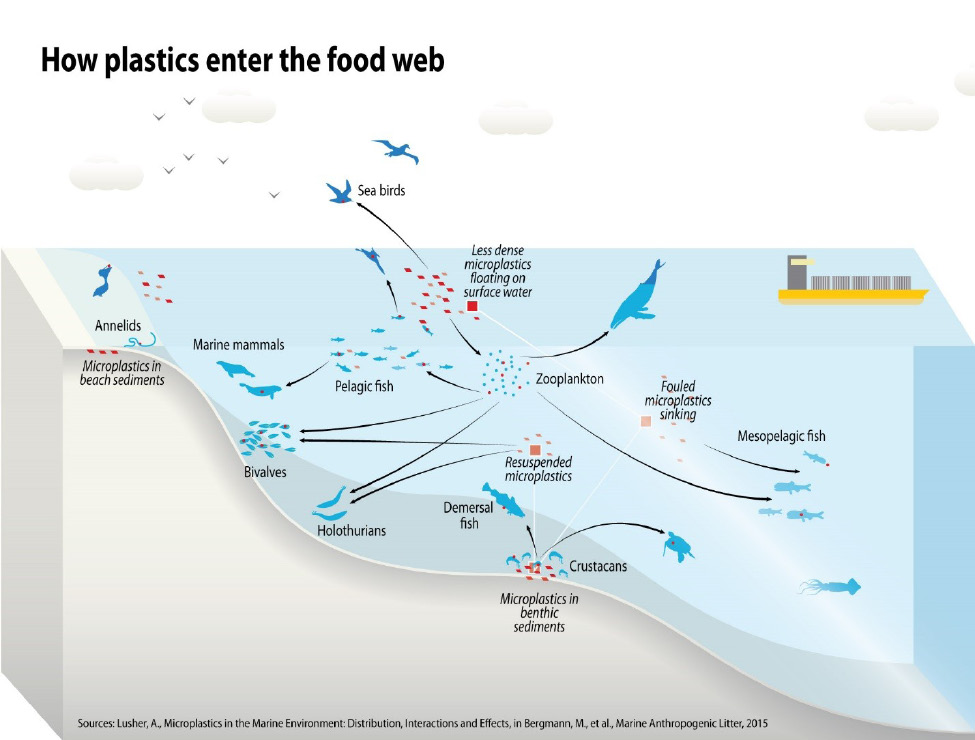
Figure 4. How microplastics enter and are dispersed through the food web.
Human health
Humans are at the top of the food chain. As plastics are transferred up the food chain, they inevitably make it into us. Below are some figures and facts about the possible exposure pathways of plastics to humans. Documented pathways of exposure include oral, dermal (skin contact), and inhalation (Galloway 2015). Despite exposure pathway documentation, scientific research and understanding of potential contamination of the human population by microplastics and associated additives (plasticizers, flame retardants, stabilizers, pigments, fillers) is in its infancy (Galloway 2015).
- Tiny plastic particles can be found in store-bought sea salt at low concentrations (0–4 microplastics per pound of salt) (Karami et al. 2017).
- One in four fish bought at the seafood market have plastic particles in their stomachs; luckily, we don’t usually eat the stomach (Rochman et al. 2015).
- One in three oysters, mussels, and clams also have small amounts of microplastics in their tissues, and we do eat those (Van Cauwenberghe & Janssen 2014, Rochman et al. 2015).
- Researchers from Belgium have estimated that seafood eaters may consume between 1,800 and 11,000 tiny pieces of plastic in their food each year!

Economic
Rain water that flows along streets or along the ground can carry litter into storm drains. Storm drains carry this water and debris to nearby rivers, streams, canals, or even directly to the ocean. Marine debris from storm water runoff includes street litter (e.g., cigarette butts), medical items (e.g., syringes), food packaging, beverage containers, and other materials. This debris can even clog storm drains and lead to increased flood events in low-lying areas.
Tourism is important to many coastal communities. Beautiful, clean beaches bring in and keep people around—dirty beaches do not. Beachgoers are worried about marine debris, and surveys show they will spend extra money to go to a “cleaner” beach (NOAA 2014). Reducing or eliminating marine debris from our beaches is critical because littered shorelines cost communities and lead to a loss of revenue for local businesses, as well. Decreasing the amount of marine debris by 75 percent can increase beach visitation by 43 percent (NOAA 2014).
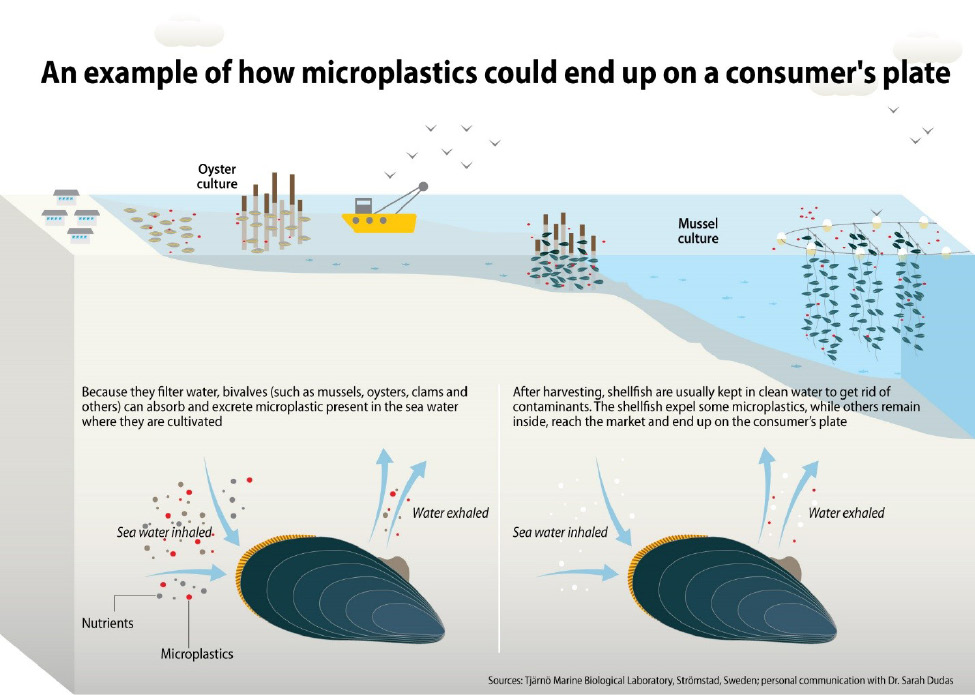
Figure 6. How filter feeding organisms (e.g., oysters, mussels, and clams) inhale and accumulate microplastics.
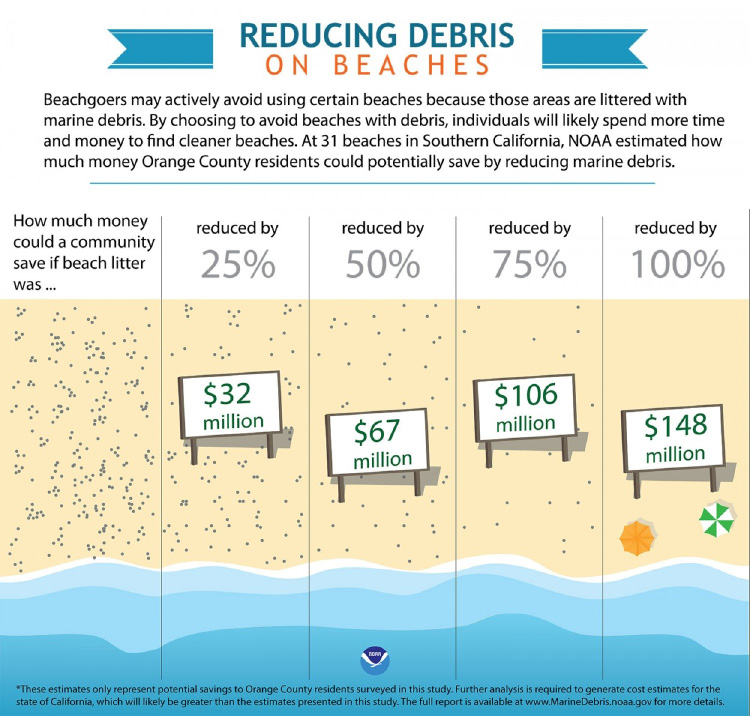
Figure 7. Economic impact of beach litter reductions. Source: National Oceanic and Atmospheric Administration (2017).
Prevention
Everyone can help prevent marine debris and the pollution of oceans and estuaries. The prevention steps require changing the way we think about, use, and dispose of products that end up as marine debris.
Refuse products that can harm you or the environment. An example would be to say no to straws. The number of straws used in the U.S. per day could fill 127 school buses or wrap around the entire Earth 21/2 times.
Reduce the amount of single-use plastics you use. Do you need a plastic grocery bag for a couple items that are easy to carry?
Reuse or repurpose items you would normally throw away. An example would be to reuse plastic grocery bags for trash containers around your house.
Recycle or dispose of trash properly. Trash should be stored in sturdy containers with lids to avoid animals or wind removing trash from the container.
Mississippi Coastal Cleanup
The Mississippi Coastal Cleanup is part of the International Coastal Cleanup Day. The cleanup event includes more than 50 sites across the three coastal Mississippi counties. It is one of the largest Mississippi volunteer events, with 2,000–4,000 volunteers participating annually. In 2016 alone, volunteers collected more than 14 tons of trash.
For more information and to learn how you can get involved, visit the Mississippi Coastal Cleanup website at www.mscoastalcleanup.org. You can learn more about our events and even register to volunteer right on the website. Adults must sign up with anyone under the age of 18; one adult can sign up for an entire class/group. Join us in protecting our beautiful coast, learning more about protecting the environment and natural resources, and having fun getting involved in the community!
Activity Ideas
- Many activities can be found in the following two resources from the NOAA Marine Debris Program.
- Talking Trash and Taking Action (https://marinedebris.noaa.gov/talking-trash-and-taking-action)
- Turning the Tide on Trash: A Learning Guide on Marine Debris (https://marinedebris.noaa.gov/sites/default/files/publications-files/2015_TurningTideonTrash_HiRes_Final.pdf)
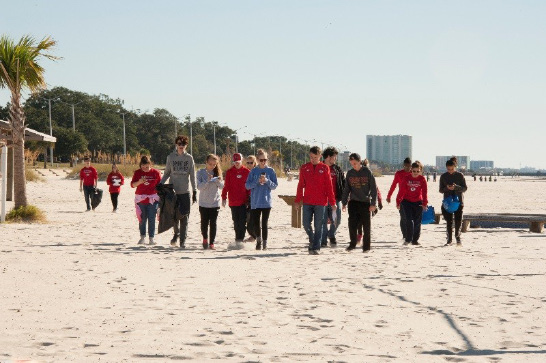
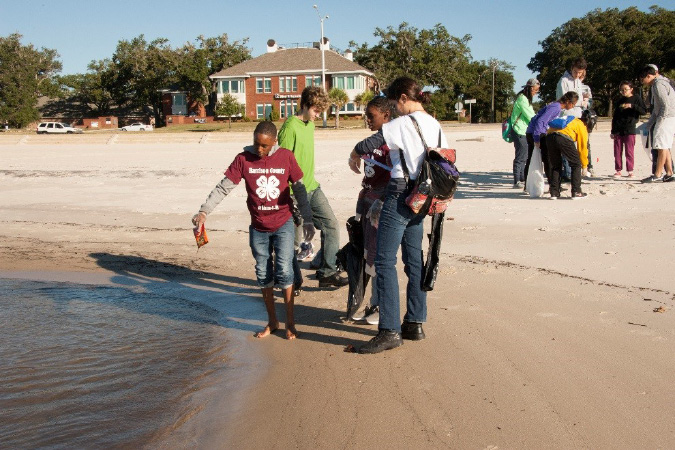
References
Galloway, T.S. 2015. “Micro- and Nano-plastics and Human Health.” In Marine Anthropogenic Litter, edited by Melanie Bergmann, Lars Gutow, Michael Klages, 343–66. Springer International Publishing.
Karami, A., Golieskardi, A., Choo, C.K., Larat, V., Galloway, T.S. 2017. “The Presence of Microplastics in Commercial Salts from Different Countries.” Nat. Publ. Gr. 1–9.
Kühn, S., Rebolledo, E.L.B., van Franeker, J.A. 2015. “Deleterious Effects of Litter on Marine Life.” In Marine Anthropogenic Litter, edited by Melanie Bergmann, Lars Gutow, Michael Klages, 75–116. Springer International Publishing.
Moore, C. J. 2008. “Synthetic Polymers in the Marine Environment: A Rapidly Increasing, Long-Term Threat.” Environmental Research 108 (2): 131–39.
National Oceanic and Atmospheric Administration (NOAA). Marine Debris Program. 2014. “Assessing the Economic Benefits of Reductions in Marine Debris: A Pilot Study of Beach Recreation in Orange County, California.” Prepared by Industrial Economics, Inc., Cambridge, MA.
National Oceanic and Atmospheric Administration (NOAA). Marine Debris Program. Office of Response and Restoration. 2017. Retrieved May 12, 2017. https://marinedebris.noaa.gov/discover-issue
Rochman, C.M., Tahir, A., Williams, S.L., Baxa, D.V, Lam, R., Miller, J.T., Teh, F.C., Werorilangi, S., Teh, S.J. 2015. “Anthropogenic Debris in Seafood: Plastic Debris and Fibers from Textiles in Fish and Bivalves Sold for Human Consumption.” Sci. Rep. 5, 14340.
Van Cauwenberghe, L., Janssen, C.R. 2014. Microplastics in Bivalves Cultured for Human Consumption. Environ. Pollut. 193: 65–70.
Wessel, C.C., Lockridge, G.R., Battiste, D., Cebriana, J. 2016. “Abundance and Characteristics of Microplastics in Beach Sediments: Insights into Microplastic Accumulation in Northern Gulf of Mexico Estuaries.” Marine Pollution Bulletin 109.1 (2016): 178–83.
World Economic Forum. 2016. “The New Plastics Economy: Rethinking the Future of Plastics.” REF 080116. Retrieved May 12, 2017. http://www3.weforum.org/docs/WEF_The_New_Plastics_ Economy.pdf
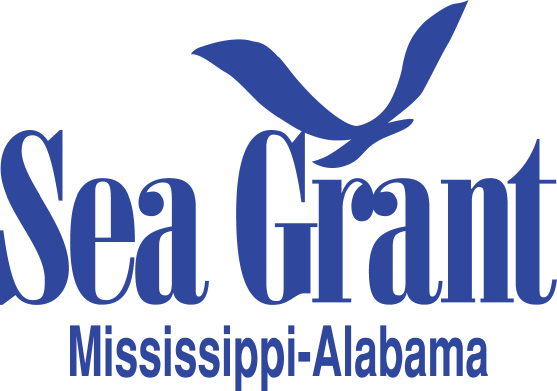
_opt.png)

Publication 3113 (POD-08-17)
MASGP-17-026
By Beth Baker, Assistant Extension Professor, MSU Wildlife, Fisheries, and Aquaculture; Caitlin Wessel, Gulf of Mexico Region Marine Debris Coordinator, NOAA; and Eric Sparks, Assistant Extension Professor, MSU Coastal Research & Extension Center, and Coastal Ecology Specialist, Mississippi-Alabama Sea Grant.The Mississippi State University Extension Service is working to ensure all web content is accessible to all users. If you need assistance accessing any of our content, please email the webteam or call 662-325-2262.




